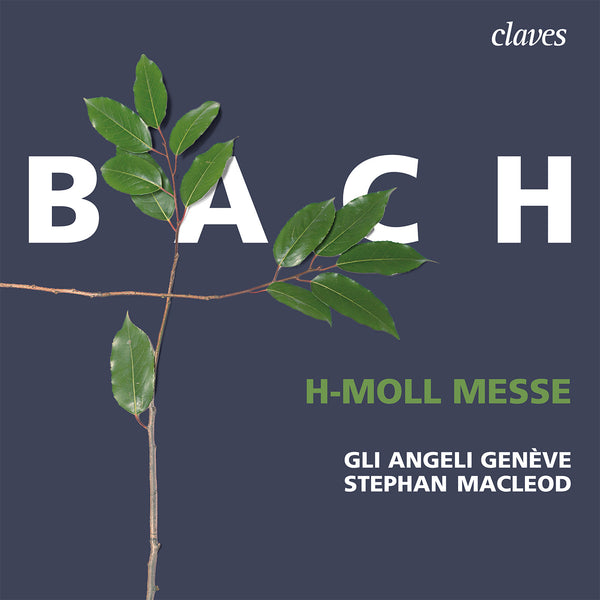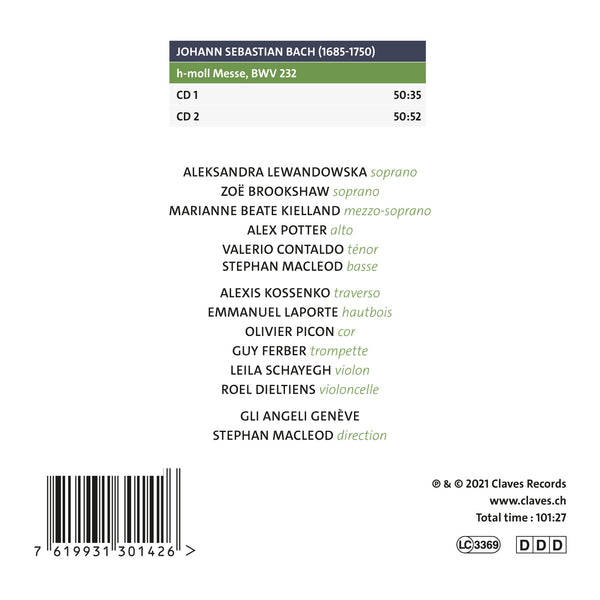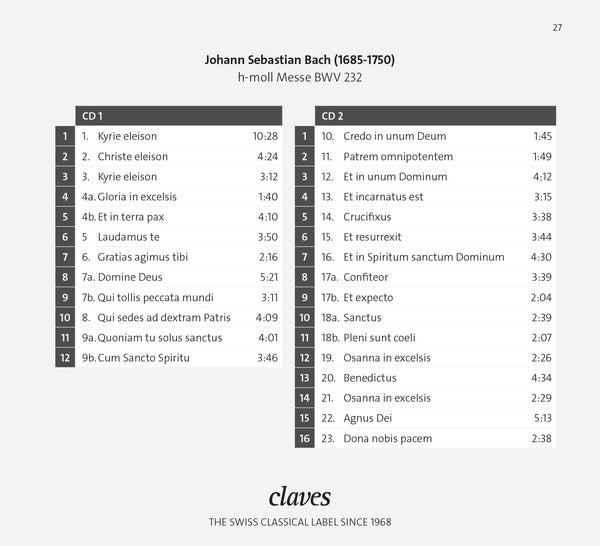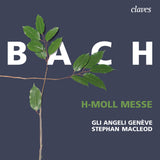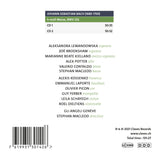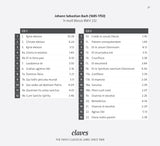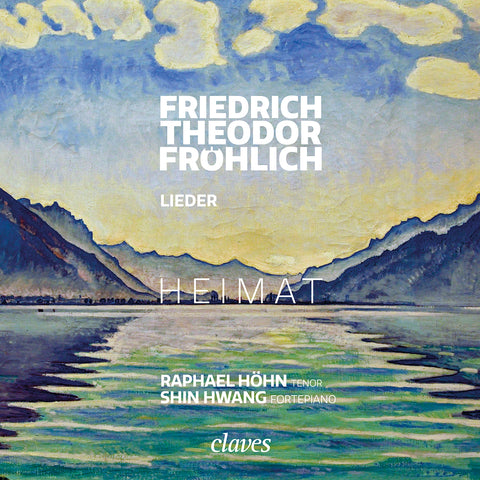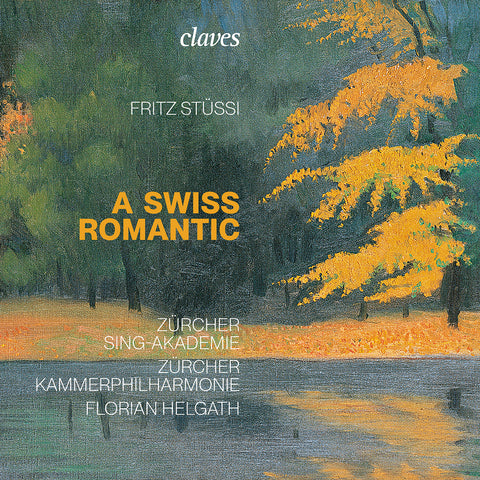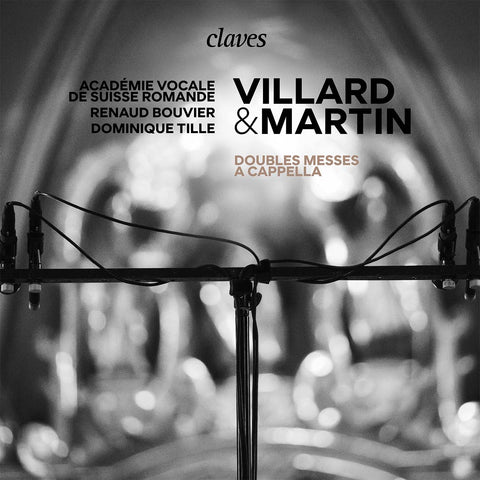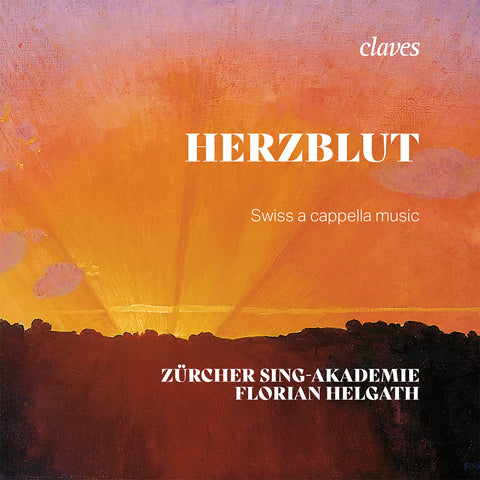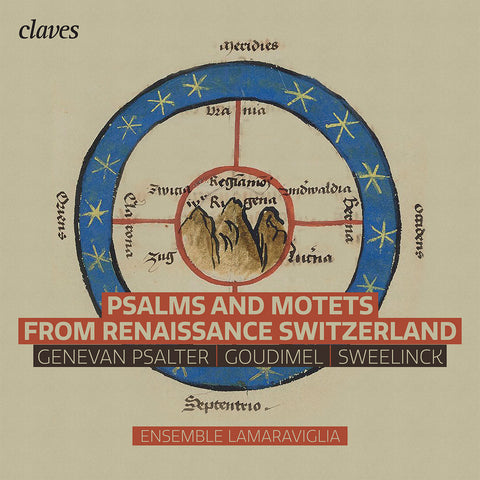(2021) Bach: h-moll Messe, Gli Angeli Genève, Stephan Macleod
Catégorie(s): Musique ancienne Chant lyrique Répertoire
Instrument(s): Violoncelle Flûte Cornet Hautbois Trompette Violon
Voix: Alto Mezzo-soprano Soprano Ténor
Compositeur principal: Johann Sebastian Bach
Ensemble: Gli Angeli Genève
Chef: Stephan MacLeod
Nb CD(s): 2
N° de catalogue:
CD 3014/15
Sortie: 26.03.2021
EAN/UPC: 7619931301426
Cet album est en repressage. Précommandez-le dès maintenant à un prix spécial.
CHF 24.00
Cet album n'est pas encore sorti. Précommandez-le dès maintenant.
CHF 24.00
CHF 24.00
TVA incluse pour la Suisse et l'UE
Frais de port offerts
TVA incluse pour la Suisse et l'UE
Frais de port offerts
Cet album est en repressage. Précommandez-le dès maintenant à un prix spécial.
CHF 24.00
This album has not been released yet.
Pre-order it at a special price now.
CHF 24.00
CHF 24.00
BACH: H-MOLL MESSE, GLI ANGELI GENÈVE, STEPHAN MACLEOD
Bach - La Messe en si mineur
La Messe en si mineur occupe une place très particulière dans l'œuvre de J.S. Bach : œuvre de grandeur, opus ultimum, elle n'a pas été composée en tant que telle mais résulte d'un assemblage de pièces écrites à différentes époques et pour différentes circonstances. Bach y travailla pendant les années 1748-1749, jusqu'à ce qu'il perde complètement la vue, qui s'était progressivement détériorée - une lettre de recommandation pour son fils Johann Christoph Friedrich, datée du 17 décembre 1749, a été écrite par Anna Magdalena, qui a imité sa signature. Le bruit courut à Leipzig que la santé du cantor s'était tellement détériorée que le conseil municipal, sur ordre du tout-puissant ministre de Saxe, auditionna le 8 juin 1749 un chef d'orchestre de Dresde, qui lui avait été recommandé pour « le futur poste de cantor de Saint-Thomas si le directeur musices Sebastian Bach venait à décéder ». À cette époque, Bach travaillait à sa Messe, qui était plus grande que tout ce qui avait été conçu auparavant[1]. Son successeur, plutôt pâle, dut attendre un an de plus pour le remplacer, Bach étant décédé le 28 juillet 1750.
***
Une messe monumentale
L'idée de rassembler des pièces tirées essentiellement du vaste corpus des cantates n'était pas inhabituelle ; plusieurs de ses contemporains, comme Haendel, avaient adopté une approche similaire, et Bach lui-même l'avait fait pour les courtes messes qu'il avait composées à la fin des années 1730[2]. On les appelait des parodies. Passer du texte allemand des cantates au texte latin des messes impliquait une adaptation des lignes vocales, avec des ajouts et des suppressions, des enrichissements polyphoniques et harmoniques, et des changements d'instrumentation. Tout au long de sa vie, Bach n'a cessé de revisiter ses œuvres en vue de les améliorer
Imaginant la réalisation d'une messe monumentale, qui peut être considérée comme un testament musical, Bach commence par explorer le répertoire de sa propre musique, tout en étudiant diverses messes d'autres compositeurs qui lui sont accessibles (et parmi les partitions étudiées, le Stabat mater de Pergolèse, qu'il a lui-même adapté). Il décida surtout d'utiliser une messe (Missa en langue luthérienne) composée en 1733 après la mort, le 1er février, d'Auguste le Fort, souverain de la Saxe luthérienne, dont dépendaient Leipzig et la Pologne catholique. Elle se compose, comme les messes luthériennes, du Kyrie et du Gloria, dont la musique est largement originale (seuls quatre des neuf morceaux du Gloria proviennent de compositions antérieures). Mais Bach voulait composer une messe avec les différentes parties de l'ordinaire catholique, avec le Credo, le Sanctus, le Benedictus et l'Agnus Dei. Face à l'ampleur des deux mouvements de la Missa, aussi impressionnants l'un que l'autre, Bach a été contraint d'écrire un Credo de grande taille
Le Kyrie de 1733 a été conçu comme un hommage au défunt, le Gloria célébrant son successeur, qui n'était autre que son propre fils (ils étaient tous deux de grands défenseurs des arts). On ne sait pas si l'œuvre a été jouée à Leipzig, ou si elle a été créée dans la capitale de la Saxe Apparemment non, aucun document ne le mentionne. Quoi qu'il en soit, la partition fut envoyée au nouveau souverain fin juillet, avec les parties séparées que plusieurs membres de la famille Bach s'étaient empressés de recopier ; elle était accompagnée d'une requête dans laquelle le cantor se plaignait des « affronts » subis à Leipzig, espérant renforcer sa position en obtenant un poste de compositeur de la cour, une fonction purement honorifique qui n'entraînait aucune obligation. Un mois plus tôt, il avait fait nommer son fils aîné, Wilhelm Friedemann, organiste de la cathédrale Sainte-Sophie de Dresde. Mais Frédéric-Auguste II est alors pris dans la guerre de succession pour le trône de Pologne, qui lui est disputé. La demande de Bach, réitérée trois ans plus tard, se concrétise alors qu'il est aux prises avec le nouveau recteur de Saint-Thomas et le conseil de Leipzig, que le souverain ordonne finalement de laisser Bach exercer son autorité musicale.
>> Plus d'informations dans le livret <<
__________
[1] La Messe en si mineur dure environ une heure et quarante minutes, ce qui en fait une œuvre très particulière, qui ne pouvait pas être intégrée à une cérémonie religieuse La Missa votiva de Zelenka, qui date de 1739 et dont la structure est assez proche de celle de Bach, dure un peu plus d'une heure (Zelenka, dont Bach connaissait la musique, était compositeur à la cour de Dresde).
[2] Outre la Missa de 1733 dont il est question ici, Bach a composé quatre messes luthériennes (composées uniquement d'un Kyrie et d'un Gloria) BWV 233 à 236.
***
Dix chanteurs pour une messe en si mineur
Depuis des années, musicologues et musiciens se penchent sur la question des effectifs vocaux dont disposait Jean-Sébastien Bach pour ses cantates et ses passions. Grâce à des sources parfois nouvellement découvertes et à des études approfondies, nous avons pu trouver des réponses éclairantes à un problème essentiel pour l'interprétation de sa musique. Dans ce contexte, il me semble important de préciser que nous n'avons pas abordé la Messe en si mineur avec un ensemble de dix chanteurs par souci d'authenticité, ni pour affirmer notre point de vue sur la manière dont les choses devraient ou ne devraient pas être faites. On oublie parfois dans cette quête d'authenticité que les musiciens, hier comme aujourd'hui, ont toujours été pragmatiques et se sont toujours adaptés aux différentes contraintes : budgets, diapasons, effectifs, instruments disponibles, etc. La réalité historique seule n'est donc pas systématiquement une notion aussi pertinente que cela, et nous n'avons pas l'ambition de participer aux débats souvent passionnants que suscitent de telles recherches. Si notre travail peut contribuer à faire évoluer certains points de vue, donner de la pertinence à d'autres, faire réagir, faire progresser certaines idées et convictions, tant mieux, mais nos propres motivations sont différentes.
Depuis sa création en 2005, Gli Angeli Genève aborde la musique de Bach avec deux chanteurs par partie : soit huit chanteurs pour la plupart des cantates, huit chanteurs pour la Passion selon saint Jean, seize pour la Passion selon saint Matthieu et ses deux chœurs (comme le montre notre enregistrement paru chez Claves en avril 2020), dix pour le Magnificat (où les chœurs ont cinq parties) ou pour la Messe en si mineur (où un effectif de douze chanteurs serait plus logique en raison du Sanctus à six voix ). Deux chanteurs par partie dans les chœurs, c'est le nombre de chanteurs du chœur de Carl Philip Emmanuel Bach pour plusieurs de ses grands oratorios, et le nombre de chanteurs du chœur de Joseph Haydn pour plusieurs de ses messes. Mais là encore, ces réalités historiques ne sont pas à la base de notre approche et de notre choix. Un musicien peut être justifié dans son besoin de légitimer ses choix esthétiques par sa connaissance de l'histoire, mais si la recherche de l'authenticité devient le seul moteur de son travail, il risque de s'égarer. C'est donc un autre facteur qui nous attire et nous motive.
À l'époque de Bach, les chanteurs de Leipzig, quel que soit leur nombre exact, chantaient devant les instrumentistes et non derrière eux. La musique religieuse existait en fonction du verbe qu'elle magnifiait, car instrumentistes et chanteurs partageaient à l'époque la même langue et la même culture. En plaçant aujourd'hui les chanteurs devant les instruments, comme nous le faisons avec Gli Angeli Genève, nous redonnons au mot la place qui lui revient : la première, celle qui fonde et inspire cette musique vocale. Et si le chœur chante devant les instruments, il n'a pas besoin d'être très nombreux, car l'équilibre entre la voix et l'orchestre est beaucoup plus facile à atteindre. C'est la différence entre la position classique d'un grand chœur derrière les instruments, la disposition avec laquelle ma génération a grandi, écouté, joué, chanté et appris cette musique, et qui est encore la plus courante aujourd'hui dans les églises et les salles de concert.
Enfin, deux voix chantant la même partie ne peuvent se fondre en un seul son ou une seule couleur de registre, comme c'est déjà le cas à trois. On est loin de la plénitude sonore du grand chœur romantique. D'un autre côté, les voix d'un tel ensemble sont plus individualisées, tant au niveau du son que de l'interprétation. Dans le cas des Gli Angeli Genève, ce sont les voix d'un groupe d'amis qui ont décidé de chanter ensemble, et de laisser leurs timbres respectifs exprimer leur bonheur et leur plaisir de laisser parler la musique.
***
Gli Angeli Geneva - www.gliangeligeneve.com
Gli Angeli Geneva a été fondé en 2005 par Stephan MacLeod. Formation de taille variable, jouant sur des instruments d'époque (ou des copies), l'ensemble est composé de musiciens ayant fait carrière dans le domaine de la musique baroque, mais qui ne sont pas uniquement actifs dans ce domaine : ils ne jouent pas uniquement de la musique ancienne. Cet éclectisme garantit la vitalité de leur enthousiasme. Il est aussi le moteur de leur curiosité.
Dès le début d'une aventure musicale qui s'est concentrée pendant plusieurs années sur l'interprétation en direct de l'intégrale des Cantates de Bach à Genève, à raison de trois concerts par saison, Gli Angeli Genève a été le théâtre de rencontres entre des chanteurs et instrumentistes parmi les plus réputés de la scène baroque internationale et de jeunes diplômés des Hautes Ecoles de Musique de Bâle, Lyon, Lausanne et Genève.
Internationalement reconnu depuis la sortie en 2009 et 2010 de ses deux premiers CD, récompensés par de nombreux prix de la critique, l'ensemble donne aujourd'hui sept à huit concerts par saison à Genève, dans le cadre de son Intégrale des Cantates de Bach d'une part, d'une série de concerts annuels au Victoria Hall d'autre part, et depuis septembre 2017 dans une nouvelle intégrale dédiée aux Symphonies de Haydn. L'ensemble est autant sollicité en Suisse qu'à l'étranger pour des interprétations de Bach, mais aussi de Tallis, Josquin, Schein, Schütz, Johann Christoph Bach, Weckmann, Buxtehude, Rosenmüller, Haydn, Mozart et d'autres encore. Ces dernières saisons, Gli Angeli Genève a été en résidence au Festival d'Utrecht et aux Thüringer Bachwochen, et s'est également produit à Bâle, Zurich, Lucerne, Barcelone, Nürnberg, Brême, Stuttgart, Bruxelles, Milan, Wroclaw, Paris, Ottawa, Vancouver, Amsterdam et La Haye. Gli Angeli Genève est régulièrement invité au Festival de Saintes, au festival d'Utrecht, au Musikfest de Brême ou encore au Bach Festival de Vancouver. L'ensemble a fait ses débuts en 2017 au Grand Théâtre de Genève et en 2019 au KKL de Lucerne.
L'avant-dernier enregistrement de Gli Angeli Genève pour Claves, Sacred Music of the 17th Century in Wroclaw, a remporté le prix ICMA 2019 du meilleur enregistrement de musique baroque vocale de l'année, et son dernier, La Passion selon saint Matthieu de Jean-Sébastien Bach, reçoit un accueil enthousiaste, tant du public que de la critique, en Suisse et dans le monde entier.
Traduit de l'Anglais avec www.DeepL.com/TranslatorREVIEWS
“This studio recording of Bach’s greatest work, though one he only ever heard in his imagination, is notable for its transparent textures due to MacLeod’s decision to limit his singers to ten – a decision taken when Gli Angeli Genève was founded in 2005. In his booklet note MacLeod persuasively argues that such restrictions are not undertaken for strict historical authenticity – other reasons pertain, including placing all the singers in front of the instrumentalists, as would have occurred in the Thomaskirche in Bach’s day. On the recording this has the benefit of foregrounding the text and thereby to an extent solving many of the balance issues that occur in a conventional set-up. [..]” -Philip Reed, August 2021
« [..] Ansonsten punktet sie mit ihrer technischen Perfektion und ihrer musikalischen Homogenität. MacLeod geht es mehr um analytische Klarheit als um spirituelle Überhöhung; dementsprechend direkt und zügig ist sein Ansatz. Von den durchweg exzellenten Instrumentalsoli ist Leila Schayeghs Geigenspiel im „Laudamus te“ besonders hervorzuheben. » - Matthias Hengelbrock, September 2021
« [..] Dans cet opus, Stephan MacLeod et son ensemble Gli Angeli Genève abordent la messe avec dix chanteurs au total. Bach faisait pareil pour ses cantates de sorte à favoriser la parole à l'orchestre. Les voix s'épanouissent et sont soutenues admirablement par l'orchestre. [..] » - Septembre 2021
“Gli Angeli Genève perform the Mass in B minor with 10 singers (six concertists and four ripienists) and an orchestra of 27 players, each section led by outstanding musicians. Director (and bass) Stephan MacLeod enthuses that two singers on each line in the choruses, placed in front of the orchestra instead of behind it, is ‘more individualised, both in sound and interpretation … their respective timbres express their happiness and pleasure in letting music speak for itself’. [..] Overall, Gli Angeli Genève’s performance is characterised by swift momentum, crisp articulation and benevolent attention to detail.” - David Vickers, July 2021
« [..] Nach der famosen Matthäus-Passion vor einem Jahr nun eine h-Moll-Messe vom selben Kaliber: Ein Plädoyer für die schlanke Vokalbesetzung, ohne ideologische Verengung oder argumentativen Schaum vor dem Mund. Im Gegenteil: Ein funkensprühendes Erlebnis hochstehender Musikalität und stupenden Vermögens. Stephan MacLeod und sein Ensemble Gli Angeli Genève treten seit längerer Zeit vernehmlich als – vielleicht weithin nicht genug geschätzte – Bach-Kraft von Rang hervor. Dazu ist es ein wunderbares künstlerisches Lebenszeichen aus dem düsteren Corona-Herbst 2020. » - Dr. Matthias Lange, Mai 2021
« Interview. Il y a un an, Stephan MacLeod émouvait déjà dans Bach. La Passion selon saint Matthieu de l’ensemble Gli Angeli Genève faisait exploser les compteurs des téléchargements de la maison Claves. Une période de confinement en chasse une autre: il faut aujourd’hui encore se contenter de captations ou d’enregistrements en ce temps de Pâques. Mais Bach est toujours là qui nous tient la main, nous console et nous rassure de la beauté du monde. Interview du chef, qui offre ce printemps la Messe en si mineur. [..] » - Elisabeth Hass, avril 2021
“[..] Emotions are relegated to the background, instead much emphasis is placed on an objective and therefore very academic interpretation, which at best can please those who like an intellectual and professorial Bach.” - Alain Steffen, mars 2021
“[..] This is a creation of a very high level of interpretation, carefully thought out and carefully realised in the context of historical performance practices and the use of appropriate instrumentation, as evidenced by the very person of the ensemble's conductor and bass player, Stephen MacLeod, an artist who researches the lesser-known Baroque repertoire. [..] If I had to characterise this recording in a few words or one sentence, I would use the following words: beautiful, honest and modest. There are many fine recordings of this repertoire, more or less famous, spectacular and exciting, but by communing with the creation of the singers and the ensemble of Gli Angeli Genève under the direction of Stephan MacLeod, I was able not only to relax but also to comfort my mind, my heart and my soul. [..]” - Paweł Chmielowski, August 2021
“[..] The smaller forces in this new recording give a lovely transparency to the overall sound, beneficial in such compositional complexity, and an intimacy missing in recordings using greater numbers. The string players use period instruments, adding to the clarity of texture. Ensemble work throughout is exceptional. The booklet lists the choir and orchestra on the front and photos of the performers are included. The comprehensive introduction is in three languages, but the Latin text is only translated into French. [..]” - Patrice Connolly, April 2022
« [..] Aber gerade deswegen ruft es Begeisterung hervor, wenn es einem erfahrenen Interpreten wie Stephan MacLeod gelingt, mit höchst sorgfältig ausgewählten Musikerinnen und Musikern ein Ensemble zu formieren, das den „Beinahe-Normalfall“ einer entsprechend routinierten Darbietung nochmals deutlich überbietet. MacLeod selbst leuchtet voran in der fordernden Doppelaufgabe des Vokalisten und Ensembleleiters. Zur vokalen Leistung gehört nicht zuletzt auch die brillante Bewältigung der beiden in der Tessitura so verschiedenen Bassarien. Zu ihm gesellen sich hervorragende Sängerinnen und Sänger, die gerade auch in der heiklen Zwei-pro-Stimme-Besetzung der Chorsätze eine erstaunliche Homogenität zu erzeugen verstehen. Gemeinsam mit den gleichermaßen brillanten Instrumentalistinnen und Instrumentalisten bringen sie es zu einer geschmeidigen Eleganz und filigranen Transparenz des Klanges, die ihresgleichen sucht. [..] » - Michael Wersin, Mai 2021
« Avec la Messe en si, la formation poursuit avec pertinence son exploration de Bach en s’attaquant à un monument. [..] » - Rocco Zacheo, avril 2021
« [..] Es gibt unendlich viele Aufnahmen der h-Moll-Messe. Eine neue lässt jetzt aufhorchen: Das Ensemble Gli Angeli Genève unter Leitung des mitsingenden Bassisten Stephan McLeod hat eine wirklich überzeugende und berückende Einspielung von Bachs Opus ultimum vorgelegt. [..] Diese CD sei allen, die Bach lieben, dringlichst empfohlen, egal wie viele Aufnahmen des exzeptionellen Werkes bereits im Regal stehen – und Erstlingen in Sachen h-Moll-Messe sowieso. Und da es ein Werk für alle (Kirchenjahres-)Zeiten ist, eignet es sich auch trefflich dafür, unter dem Christbaum zu liegen. » - Reinhard Mawick, November 2022
(2021) Bach: h-moll Messe, Gli Angeli Genève, Stephan Macleod - CD 3014/15
Bach - La Messe en si mineur
La Messe en si mineur occupe une place très particulière dans l'œuvre de J.S. Bach : œuvre de grandeur, opus ultimum, elle n'a pas été composée en tant que telle mais résulte d'un assemblage de pièces écrites à différentes époques et pour différentes circonstances. Bach y travailla pendant les années 1748-1749, jusqu'à ce qu'il perde complètement la vue, qui s'était progressivement détériorée - une lettre de recommandation pour son fils Johann Christoph Friedrich, datée du 17 décembre 1749, a été écrite par Anna Magdalena, qui a imité sa signature. Le bruit courut à Leipzig que la santé du cantor s'était tellement détériorée que le conseil municipal, sur ordre du tout-puissant ministre de Saxe, auditionna le 8 juin 1749 un chef d'orchestre de Dresde, qui lui avait été recommandé pour « le futur poste de cantor de Saint-Thomas si le directeur musices Sebastian Bach venait à décéder ». À cette époque, Bach travaillait à sa Messe, qui était plus grande que tout ce qui avait été conçu auparavant[1]. Son successeur, plutôt pâle, dut attendre un an de plus pour le remplacer, Bach étant décédé le 28 juillet 1750.
***
Une messe monumentale
L'idée de rassembler des pièces tirées essentiellement du vaste corpus des cantates n'était pas inhabituelle ; plusieurs de ses contemporains, comme Haendel, avaient adopté une approche similaire, et Bach lui-même l'avait fait pour les courtes messes qu'il avait composées à la fin des années 1730[2]. On les appelait des parodies. Passer du texte allemand des cantates au texte latin des messes impliquait une adaptation des lignes vocales, avec des ajouts et des suppressions, des enrichissements polyphoniques et harmoniques, et des changements d'instrumentation. Tout au long de sa vie, Bach n'a cessé de revisiter ses œuvres en vue de les améliorer
Imaginant la réalisation d'une messe monumentale, qui peut être considérée comme un testament musical, Bach commence par explorer le répertoire de sa propre musique, tout en étudiant diverses messes d'autres compositeurs qui lui sont accessibles (et parmi les partitions étudiées, le Stabat mater de Pergolèse, qu'il a lui-même adapté). Il décida surtout d'utiliser une messe (Missa en langue luthérienne) composée en 1733 après la mort, le 1er février, d'Auguste le Fort, souverain de la Saxe luthérienne, dont dépendaient Leipzig et la Pologne catholique. Elle se compose, comme les messes luthériennes, du Kyrie et du Gloria, dont la musique est largement originale (seuls quatre des neuf morceaux du Gloria proviennent de compositions antérieures). Mais Bach voulait composer une messe avec les différentes parties de l'ordinaire catholique, avec le Credo, le Sanctus, le Benedictus et l'Agnus Dei. Face à l'ampleur des deux mouvements de la Missa, aussi impressionnants l'un que l'autre, Bach a été contraint d'écrire un Credo de grande taille
Le Kyrie de 1733 a été conçu comme un hommage au défunt, le Gloria célébrant son successeur, qui n'était autre que son propre fils (ils étaient tous deux de grands défenseurs des arts). On ne sait pas si l'œuvre a été jouée à Leipzig, ou si elle a été créée dans la capitale de la Saxe Apparemment non, aucun document ne le mentionne. Quoi qu'il en soit, la partition fut envoyée au nouveau souverain fin juillet, avec les parties séparées que plusieurs membres de la famille Bach s'étaient empressés de recopier ; elle était accompagnée d'une requête dans laquelle le cantor se plaignait des « affronts » subis à Leipzig, espérant renforcer sa position en obtenant un poste de compositeur de la cour, une fonction purement honorifique qui n'entraînait aucune obligation. Un mois plus tôt, il avait fait nommer son fils aîné, Wilhelm Friedemann, organiste de la cathédrale Sainte-Sophie de Dresde. Mais Frédéric-Auguste II est alors pris dans la guerre de succession pour le trône de Pologne, qui lui est disputé. La demande de Bach, réitérée trois ans plus tard, se concrétise alors qu'il est aux prises avec le nouveau recteur de Saint-Thomas et le conseil de Leipzig, que le souverain ordonne finalement de laisser Bach exercer son autorité musicale.
>> Plus d'informations dans le livret <<
__________
[1] La Messe en si mineur dure environ une heure et quarante minutes, ce qui en fait une œuvre très particulière, qui ne pouvait pas être intégrée à une cérémonie religieuse La Missa votiva de Zelenka, qui date de 1739 et dont la structure est assez proche de celle de Bach, dure un peu plus d'une heure (Zelenka, dont Bach connaissait la musique, était compositeur à la cour de Dresde).
[2] Outre la Missa de 1733 dont il est question ici, Bach a composé quatre messes luthériennes (composées uniquement d'un Kyrie et d'un Gloria) BWV 233 à 236.
***
Dix chanteurs pour une messe en si mineur
Depuis des années, musicologues et musiciens se penchent sur la question des effectifs vocaux dont disposait Jean-Sébastien Bach pour ses cantates et ses passions. Grâce à des sources parfois nouvellement découvertes et à des études approfondies, nous avons pu trouver des réponses éclairantes à un problème essentiel pour l'interprétation de sa musique. Dans ce contexte, il me semble important de préciser que nous n'avons pas abordé la Messe en si mineur avec un ensemble de dix chanteurs par souci d'authenticité, ni pour affirmer notre point de vue sur la manière dont les choses devraient ou ne devraient pas être faites. On oublie parfois dans cette quête d'authenticité que les musiciens, hier comme aujourd'hui, ont toujours été pragmatiques et se sont toujours adaptés aux différentes contraintes : budgets, diapasons, effectifs, instruments disponibles, etc. La réalité historique seule n'est donc pas systématiquement une notion aussi pertinente que cela, et nous n'avons pas l'ambition de participer aux débats souvent passionnants que suscitent de telles recherches. Si notre travail peut contribuer à faire évoluer certains points de vue, donner de la pertinence à d'autres, faire réagir, faire progresser certaines idées et convictions, tant mieux, mais nos propres motivations sont différentes.
Depuis sa création en 2005, Gli Angeli Genève aborde la musique de Bach avec deux chanteurs par partie : soit huit chanteurs pour la plupart des cantates, huit chanteurs pour la Passion selon saint Jean, seize pour la Passion selon saint Matthieu et ses deux chœurs (comme le montre notre enregistrement paru chez Claves en avril 2020), dix pour le Magnificat (où les chœurs ont cinq parties) ou pour la Messe en si mineur (où un effectif de douze chanteurs serait plus logique en raison du Sanctus à six voix ). Deux chanteurs par partie dans les chœurs, c'est le nombre de chanteurs du chœur de Carl Philip Emmanuel Bach pour plusieurs de ses grands oratorios, et le nombre de chanteurs du chœur de Joseph Haydn pour plusieurs de ses messes. Mais là encore, ces réalités historiques ne sont pas à la base de notre approche et de notre choix. Un musicien peut être justifié dans son besoin de légitimer ses choix esthétiques par sa connaissance de l'histoire, mais si la recherche de l'authenticité devient le seul moteur de son travail, il risque de s'égarer. C'est donc un autre facteur qui nous attire et nous motive.
À l'époque de Bach, les chanteurs de Leipzig, quel que soit leur nombre exact, chantaient devant les instrumentistes et non derrière eux. La musique religieuse existait en fonction du verbe qu'elle magnifiait, car instrumentistes et chanteurs partageaient à l'époque la même langue et la même culture. En plaçant aujourd'hui les chanteurs devant les instruments, comme nous le faisons avec Gli Angeli Genève, nous redonnons au mot la place qui lui revient : la première, celle qui fonde et inspire cette musique vocale. Et si le chœur chante devant les instruments, il n'a pas besoin d'être très nombreux, car l'équilibre entre la voix et l'orchestre est beaucoup plus facile à atteindre. C'est la différence entre la position classique d'un grand chœur derrière les instruments, la disposition avec laquelle ma génération a grandi, écouté, joué, chanté et appris cette musique, et qui est encore la plus courante aujourd'hui dans les églises et les salles de concert.
Enfin, deux voix chantant la même partie ne peuvent se fondre en un seul son ou une seule couleur de registre, comme c'est déjà le cas à trois. On est loin de la plénitude sonore du grand chœur romantique. D'un autre côté, les voix d'un tel ensemble sont plus individualisées, tant au niveau du son que de l'interprétation. Dans le cas des Gli Angeli Genève, ce sont les voix d'un groupe d'amis qui ont décidé de chanter ensemble, et de laisser leurs timbres respectifs exprimer leur bonheur et leur plaisir de laisser parler la musique.
***
Gli Angeli Geneva - www.gliangeligeneve.com
Gli Angeli Geneva a été fondé en 2005 par Stephan MacLeod. Formation de taille variable, jouant sur des instruments d'époque (ou des copies), l'ensemble est composé de musiciens ayant fait carrière dans le domaine de la musique baroque, mais qui ne sont pas uniquement actifs dans ce domaine : ils ne jouent pas uniquement de la musique ancienne. Cet éclectisme garantit la vitalité de leur enthousiasme. Il est aussi le moteur de leur curiosité.
Dès le début d'une aventure musicale qui s'est concentrée pendant plusieurs années sur l'interprétation en direct de l'intégrale des Cantates de Bach à Genève, à raison de trois concerts par saison, Gli Angeli Genève a été le théâtre de rencontres entre des chanteurs et instrumentistes parmi les plus réputés de la scène baroque internationale et de jeunes diplômés des Hautes Ecoles de Musique de Bâle, Lyon, Lausanne et Genève.
Internationalement reconnu depuis la sortie en 2009 et 2010 de ses deux premiers CD, récompensés par de nombreux prix de la critique, l'ensemble donne aujourd'hui sept à huit concerts par saison à Genève, dans le cadre de son Intégrale des Cantates de Bach d'une part, d'une série de concerts annuels au Victoria Hall d'autre part, et depuis septembre 2017 dans une nouvelle intégrale dédiée aux Symphonies de Haydn. L'ensemble est autant sollicité en Suisse qu'à l'étranger pour des interprétations de Bach, mais aussi de Tallis, Josquin, Schein, Schütz, Johann Christoph Bach, Weckmann, Buxtehude, Rosenmüller, Haydn, Mozart et d'autres encore. Ces dernières saisons, Gli Angeli Genève a été en résidence au Festival d'Utrecht et aux Thüringer Bachwochen, et s'est également produit à Bâle, Zurich, Lucerne, Barcelone, Nürnberg, Brême, Stuttgart, Bruxelles, Milan, Wroclaw, Paris, Ottawa, Vancouver, Amsterdam et La Haye. Gli Angeli Genève est régulièrement invité au Festival de Saintes, au festival d'Utrecht, au Musikfest de Brême ou encore au Bach Festival de Vancouver. L'ensemble a fait ses débuts en 2017 au Grand Théâtre de Genève et en 2019 au KKL de Lucerne.
L'avant-dernier enregistrement de Gli Angeli Genève pour Claves, Sacred Music of the 17th Century in Wroclaw, a remporté le prix ICMA 2019 du meilleur enregistrement de musique baroque vocale de l'année, et son dernier, La Passion selon saint Matthieu de Jean-Sébastien Bach, reçoit un accueil enthousiaste, tant du public que de la critique, en Suisse et dans le monde entier.
Traduit de l'Anglais avec www.DeepL.com/TranslatorREVIEWS
“This studio recording of Bach’s greatest work, though one he only ever heard in his imagination, is notable for its transparent textures due to MacLeod’s decision to limit his singers to ten – a decision taken when Gli Angeli Genève was founded in 2005. In his booklet note MacLeod persuasively argues that such restrictions are not undertaken for strict historical authenticity – other reasons pertain, including placing all the singers in front of the instrumentalists, as would have occurred in the Thomaskirche in Bach’s day. On the recording this has the benefit of foregrounding the text and thereby to an extent solving many of the balance issues that occur in a conventional set-up. [..]” -Philip Reed, August 2021
« [..] Ansonsten punktet sie mit ihrer technischen Perfektion und ihrer musikalischen Homogenität. MacLeod geht es mehr um analytische Klarheit als um spirituelle Überhöhung; dementsprechend direkt und zügig ist sein Ansatz. Von den durchweg exzellenten Instrumentalsoli ist Leila Schayeghs Geigenspiel im „Laudamus te“ besonders hervorzuheben. » - Matthias Hengelbrock, September 2021
« [..] Dans cet opus, Stephan MacLeod et son ensemble Gli Angeli Genève abordent la messe avec dix chanteurs au total. Bach faisait pareil pour ses cantates de sorte à favoriser la parole à l'orchestre. Les voix s'épanouissent et sont soutenues admirablement par l'orchestre. [..] » - Septembre 2021
“Gli Angeli Genève perform the Mass in B minor with 10 singers (six concertists and four ripienists) and an orchestra of 27 players, each section led by outstanding musicians. Director (and bass) Stephan MacLeod enthuses that two singers on each line in the choruses, placed in front of the orchestra instead of behind it, is ‘more individualised, both in sound and interpretation … their respective timbres express their happiness and pleasure in letting music speak for itself’. [..] Overall, Gli Angeli Genève’s performance is characterised by swift momentum, crisp articulation and benevolent attention to detail.” - David Vickers, July 2021
« [..] Nach der famosen Matthäus-Passion vor einem Jahr nun eine h-Moll-Messe vom selben Kaliber: Ein Plädoyer für die schlanke Vokalbesetzung, ohne ideologische Verengung oder argumentativen Schaum vor dem Mund. Im Gegenteil: Ein funkensprühendes Erlebnis hochstehender Musikalität und stupenden Vermögens. Stephan MacLeod und sein Ensemble Gli Angeli Genève treten seit längerer Zeit vernehmlich als – vielleicht weithin nicht genug geschätzte – Bach-Kraft von Rang hervor. Dazu ist es ein wunderbares künstlerisches Lebenszeichen aus dem düsteren Corona-Herbst 2020. » - Dr. Matthias Lange, Mai 2021
« Interview. Il y a un an, Stephan MacLeod émouvait déjà dans Bach. La Passion selon saint Matthieu de l’ensemble Gli Angeli Genève faisait exploser les compteurs des téléchargements de la maison Claves. Une période de confinement en chasse une autre: il faut aujourd’hui encore se contenter de captations ou d’enregistrements en ce temps de Pâques. Mais Bach est toujours là qui nous tient la main, nous console et nous rassure de la beauté du monde. Interview du chef, qui offre ce printemps la Messe en si mineur. [..] » - Elisabeth Hass, avril 2021
“[..] Emotions are relegated to the background, instead much emphasis is placed on an objective and therefore very academic interpretation, which at best can please those who like an intellectual and professorial Bach.” - Alain Steffen, mars 2021
“[..] This is a creation of a very high level of interpretation, carefully thought out and carefully realised in the context of historical performance practices and the use of appropriate instrumentation, as evidenced by the very person of the ensemble's conductor and bass player, Stephen MacLeod, an artist who researches the lesser-known Baroque repertoire. [..] If I had to characterise this recording in a few words or one sentence, I would use the following words: beautiful, honest and modest. There are many fine recordings of this repertoire, more or less famous, spectacular and exciting, but by communing with the creation of the singers and the ensemble of Gli Angeli Genève under the direction of Stephan MacLeod, I was able not only to relax but also to comfort my mind, my heart and my soul. [..]” - Paweł Chmielowski, August 2021
“[..] The smaller forces in this new recording give a lovely transparency to the overall sound, beneficial in such compositional complexity, and an intimacy missing in recordings using greater numbers. The string players use period instruments, adding to the clarity of texture. Ensemble work throughout is exceptional. The booklet lists the choir and orchestra on the front and photos of the performers are included. The comprehensive introduction is in three languages, but the Latin text is only translated into French. [..]” - Patrice Connolly, April 2022
« [..] Aber gerade deswegen ruft es Begeisterung hervor, wenn es einem erfahrenen Interpreten wie Stephan MacLeod gelingt, mit höchst sorgfältig ausgewählten Musikerinnen und Musikern ein Ensemble zu formieren, das den „Beinahe-Normalfall“ einer entsprechend routinierten Darbietung nochmals deutlich überbietet. MacLeod selbst leuchtet voran in der fordernden Doppelaufgabe des Vokalisten und Ensembleleiters. Zur vokalen Leistung gehört nicht zuletzt auch die brillante Bewältigung der beiden in der Tessitura so verschiedenen Bassarien. Zu ihm gesellen sich hervorragende Sängerinnen und Sänger, die gerade auch in der heiklen Zwei-pro-Stimme-Besetzung der Chorsätze eine erstaunliche Homogenität zu erzeugen verstehen. Gemeinsam mit den gleichermaßen brillanten Instrumentalistinnen und Instrumentalisten bringen sie es zu einer geschmeidigen Eleganz und filigranen Transparenz des Klanges, die ihresgleichen sucht. [..] » - Michael Wersin, Mai 2021
« Avec la Messe en si, la formation poursuit avec pertinence son exploration de Bach en s’attaquant à un monument. [..] » - Rocco Zacheo, avril 2021
« [..] Es gibt unendlich viele Aufnahmen der h-Moll-Messe. Eine neue lässt jetzt aufhorchen: Das Ensemble Gli Angeli Genève unter Leitung des mitsingenden Bassisten Stephan McLeod hat eine wirklich überzeugende und berückende Einspielung von Bachs Opus ultimum vorgelegt. [..] Diese CD sei allen, die Bach lieben, dringlichst empfohlen, egal wie viele Aufnahmen des exzeptionellen Werkes bereits im Regal stehen – und Erstlingen in Sachen h-Moll-Messe sowieso. Und da es ein Werk für alle (Kirchenjahres-)Zeiten ist, eignet es sich auch trefflich dafür, unter dem Christbaum zu liegen. » - Reinhard Mawick, November 2022
Return to the album | Read the booklet | Composer(s): Johann Sebastian Bach | Main Artist: Stephan MacLeod




STUDIO MASTER (AUDIO HAUTE-RÉSOLUTION)
Alto
Amethys Design
Chant lyrique
Cornet
Emmanuel Laporte
En stock
Flûte
Gli Angeli Genève
Hautbois
Johann Sebastian Bach (1685-1750)
Mezzo-soprano
Musique ancienne
Musique Haute-résolution - Qualité master studio
Répertoire
Soprano
Stephan MacLeod
Tous les albums
Trompette
Ténor
Violon
Violoncelle
Alto
Amethys Design
Chant lyrique
Cornet
Emmanuel Laporte
En stock
Flûte
Gli Angeli Genève
Hautbois
Johann Sebastian Bach (1685-1750)
Mezzo-soprano
Musique ancienne
Musique Haute-résolution - Qualité master studio
Répertoire
Soprano
Stephan MacLeod
Tous les albums
Trompette
Ténor
Violon
Violoncelle







